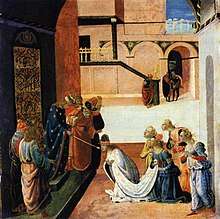Jacopo da Sellaio
Jacopo del Sellaio (1441/1–1493[1]), was an Italian painter of the early Renaissance, active in his native Florence. His real name was Jacopo di Arcangelo. The nickname Sellaio derives from the profession of his father, a saddler.
Jacopo del Sellaio | |
|---|---|
 Jacopo del Sellaio, Esther Before Ahasuerus, c. 1490, Museum of Fine Arts, Budapest | |
| Born | 1441/2 Florence, Italy[1] |
| Died | 1493 (aged 51–52) Florence, Italy[1] |
| Nationality | Italian |
| Education | Filippo Lippi |
| Known for | Painting |
According to Vasari, Sellaio was a pupil of Fra Filippo Lippi at the same time as Sandro Botticelli, who became a lasting influence on him.[2] He joined the Florentine painters' confraternity the Compagnia di San Luca in 1460, and by 1472 he was sharing a workshop with Biagio d'Antonio. In 1473 he formed a partnership with Filippo di Giuliano that was maintained until Sellaio's death in 1493. In 1490 Sellaio and Filippo took on a third partner, Zanobi di Giovanni.[3] Neither Filippo nor Zanobi's extant works have been identified, but the former is sometimes associated with the anonymous painter known as the Master of the Fiesole Epiphany.[4]
Sellaio is today best known paintings for the paintings that he executed for the fronts of cassoni, or wedding chests. His most famous such commission are the Morelli and Nerli cassoni of 1472 (now London, Courtauld Institute Gallery), which were manufactured by the carpenter Zanobi di Domenico and painted in collaboration with Biagio d'Antonio. Sellaio's three panels with the Story of Esther, now in the Uffizi Gallery, Florence, were also once part of a pair of cassoni along with two other panels now in the Museum of Fine Arts, Budapest and the Louvre, Paris.
Sellaio also produced a large number of small devotional panels intended for domestic interiors, including many of the Saint Jerome and Saint John the Baptist. His altarpieces include two panels of the Annunciation for Santa Lucia de' Magnoli, Florence, painted around 1473; a Pietà commissioned in 1483 for the chapel of the Compagnia di San Frediano, called La Brucciata, in the Florentine church of the same name (later at the Kaiser Friedrich Museum, Berlin, and destroyed in 1945); and a Crucifixion painted in 1490-93 for another chapel in San Frediano, now in the church of seventeenth-century church of San Frediano in Cestello, Florence.
His son, Arcangelo (1477/78-1531), was also a painter, and is responsible for the body of work formerly attributed to the Master of the Miller Tondo.[5]
Selected works
| Wikimedia Commons has media related to Jacopo del Sellaio. |
- 1472 – The Morelli-Nerli Cassone, wood cassone decorated with paintings (Courtauld Institute Galleries)[6]
- ca 1473 -- Annunciation (church of Santa Lucia dei Magnoli, Florence)
- ca 1475/80 – Story of Cupid and Psyche, two panels (Fitzwilliam Museum; private collection)[7]
- 1470s – Madonna and Child with Saints Lucy, Sebastian, John the Baptist and Catherine (Ackland Art Museum)[8]
- 1480 – Saint John the Baptist, (National Gallery of Art)[9]
- 1480s – Saint Jerome and Saint Francis (El Paso Museum of Art)[10]
- 1483-86 -- Pietà with Saints Fridian and Jerome (formerly Kaiser Friedrich Museum, Berlin; destroyed in 1945)
- 1480/85 – Votive Altarpiece: The Trinity, the Virgin, St. John and Donors (The National Museum of Western Art)[11]
- ca 1485 – Saint John the Baptist (Museum of Fine Arts)[12]
- ca 1485 – Madonna and Child with the Infant, Saint John the Baptist and Attending Angel, oil on panel (Fine Arts Museums of San Francisco)[1]
- ca 1485 – The Legend of Brutus and Portia, oil on panel (Fine Arts Museums of San Francisco)[13]
- 1480s – The Reconciliation of the Romans and Sabines, tempera and gold on panel (Philadelphia Museum of Art)[14]
- ca 1485-90 - Death of Eurydice; Eurydice Taken to Hades; Orpheus Playing Among the Animals, three panels (Museum Boijmans Van Beuningen, Rotterdam; Khanenko Museum of Art, Kiev; Wawel Castle, Cracow)
- ca 1490 – Scenes from the Story of Esther (Uffizi Gallery; Museum of Fine Arts; Louvre) [2]
- 1490-93 -- Crucifixion with the Virgin and Saints Fridian, Catherine of Alexandria, John the Evangelist, Sebastian, Tobias and the Angel and Lawrence (church of San Frediano in Cestello, Florence).
References
- Kren, Emil; Marx, Daniel. "Jacopo del Sellaio". Web Gallery of Art. Retrieved April 25, 2009.
- Kren, Emil; Marx, Daniel. "The Banquet of Ahasuerus". Web Gallery of Art. Retrieved April 25, 2009.
- Pons, Nicoletta (1991). "Zanobi di Giovanni e le compagnie di pittori". Rivista d'arte: 221–227.
- Fahy, Everett (2003). "The Este predella panels and other works by the Master of the Fiesole Epiphany". Nuovi Studi. 6/7: 17–29.
- Pons, Nicoletta (1996). "Arcangelo di Jacopo del Sellaio". Arte Cristiana. 84: 374–388.
- "Cassone by Jacopo del Sellaio". Web Gallery of Art. Retrieved April 25, 2009.
- "Pharos Collection: Italy 1400–1700". Fitzwilliam Museum. Retrieved April 25, 2009.
- "Madonna and Child with Saints Lucy, Sebastian, John the Baptist and Catherine". Ackland Art Museum. Retrieved April 25, 2009.
- "Saint John the Baptist by Jacopo del Sellaio". Web Gallery of Art. Retrieved April 25, 2009.
- "St. Jerome and St. Francis". Kress Foundation. Retrieved April 25, 2009.
- "Votive Altarpiece: the Trinity, the Virgin, St. John and Donors". The National Museum of Western Art. Retrieved April 25, 2009.
- "St John the Baptist by Jacopo da Sellaio". Web Gallery of Art. Retrieved April 25, 2009.
- "The Legend of Brutus and Portia circa 1485". Fine Arts Museums of San Francisco. Archived from the original on October 12, 2007. Retrieved April 25, 2009.
- "The Reconciliation of the Romans and Sabines". Philadelphia Museum of Art. Retrieved April 25, 2009.
External links
- Sellaio biography at the Web Gallery of Art
- Italian Paintings: Florentine School, a collection catalog containing information about Sellaio and his works (see pages: 170-171; MMA #41.100.10).